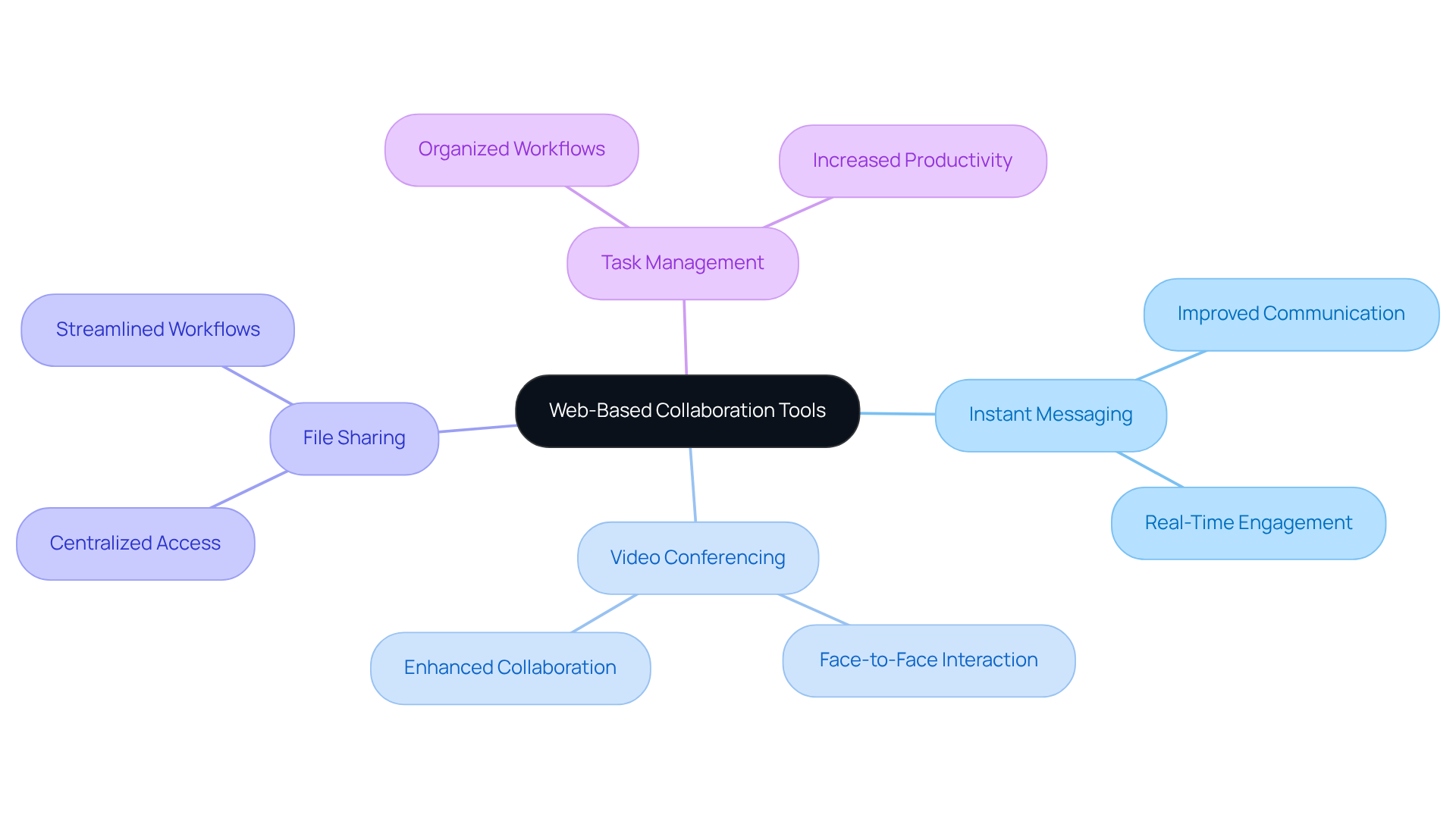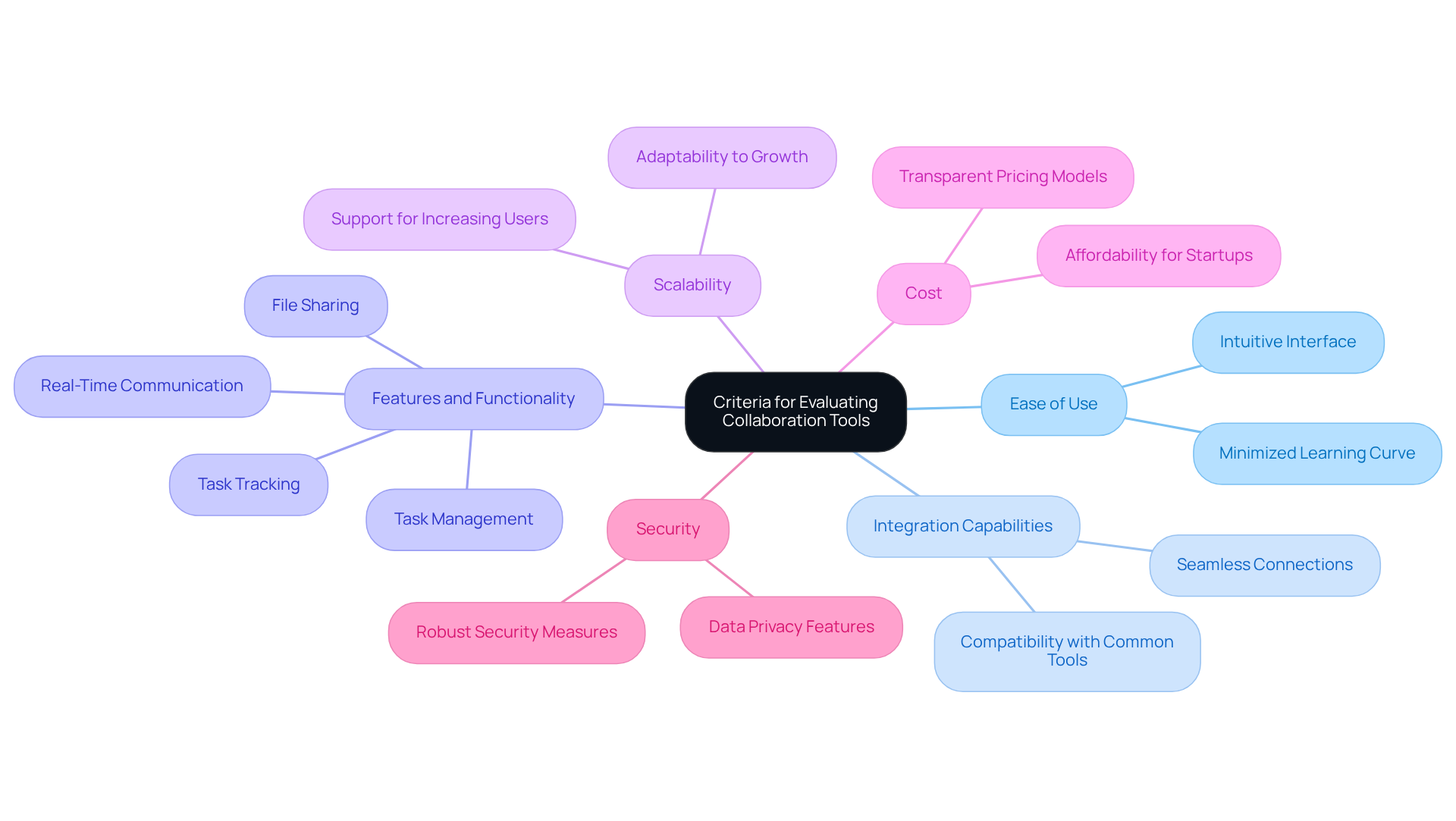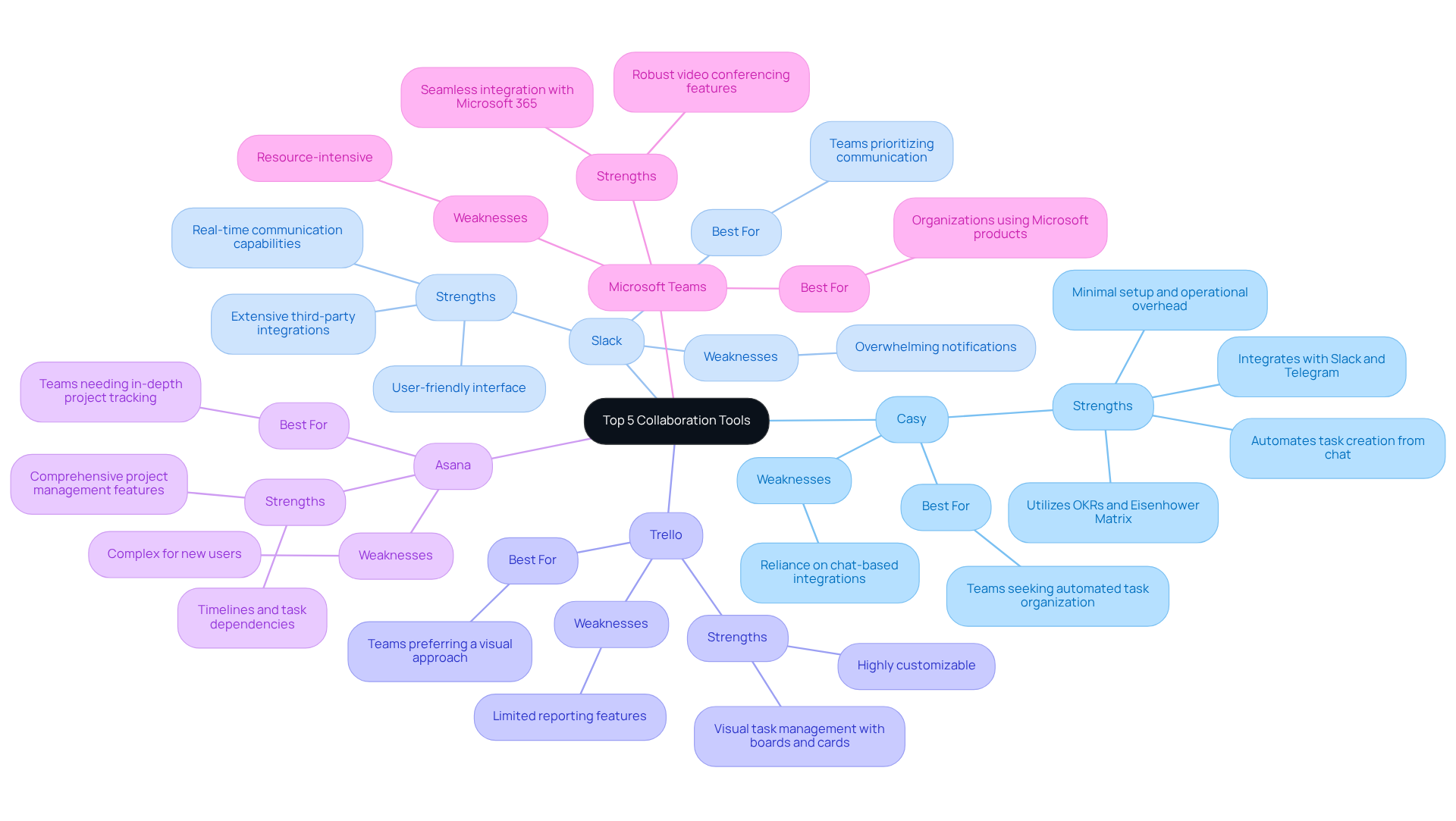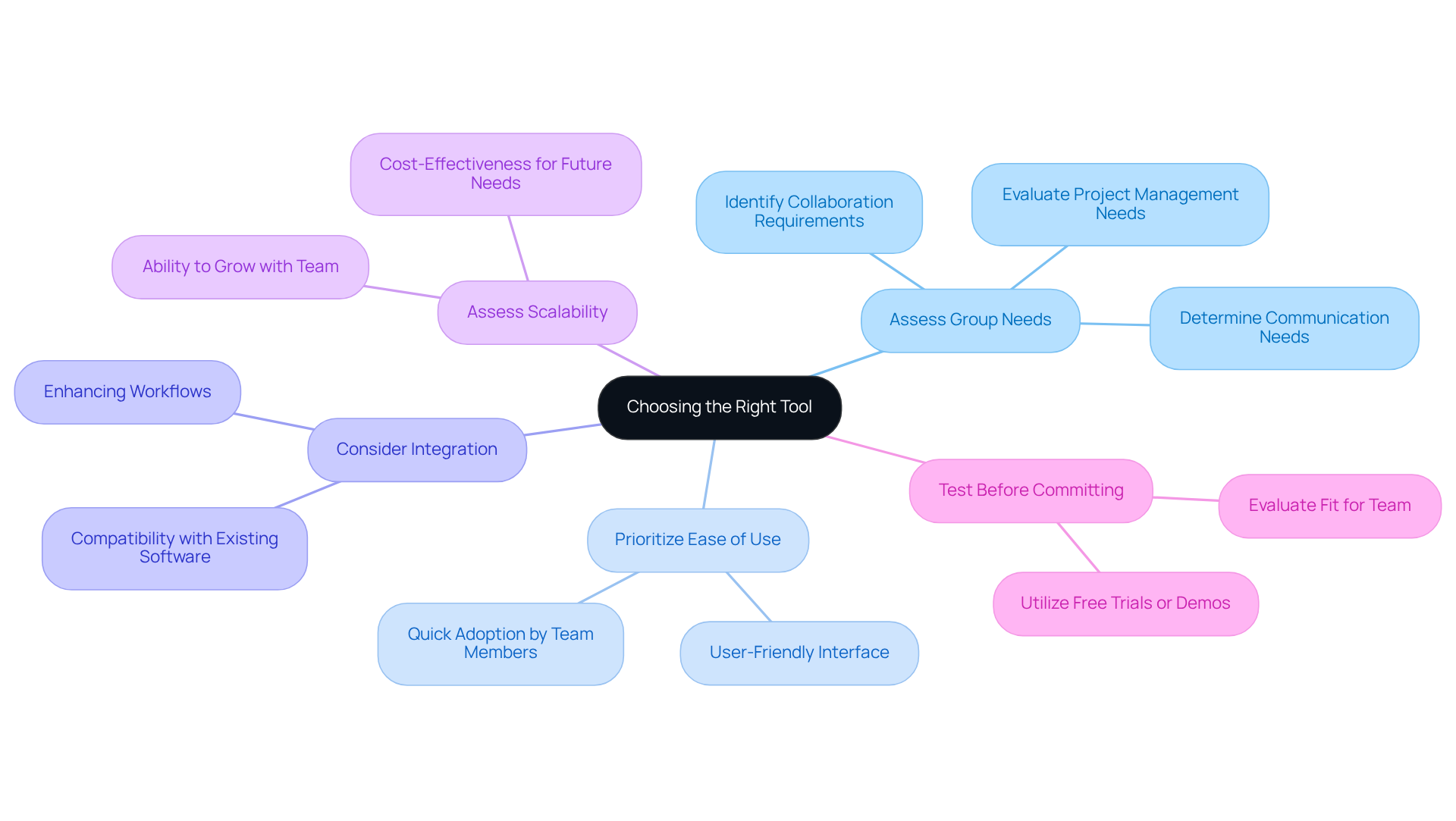Overview
Web-based collaboration tools are indispensable for startups, significantly enhancing teamwork and communication, streamlining workflows, and boosting productivity in today's digital work environment. This article underscores their importance by detailing key functionalities such as:
- Task management
- Real-time communication
Furthermore, it offers a comparative analysis of leading tools, highlighting their strengths and weaknesses to empower startups in selecting the most suitable options for their unique needs.
Introduction
Web-based collaboration tools have fundamentally transformed how teams communicate and collaborate, especially for startups navigating the intricacies of remote operations. These digital platforms not only boost productivity but also streamline workflows, allowing teams to concentrate on their core objectives without the encumbrance of administrative tasks. Yet, with a multitude of options at their disposal, how can startups identify which tools will most effectively cater to their specific needs and propel project success? This article explores the top five essential web-based collaboration tools, assessing their strengths and weaknesses to assist startups in making informed decisions within a competitive landscape.
Understanding Web-Based Collaboration Tools
Web-based collaboration tools are essential digital platforms that greatly improve teamwork and communication for remote or distributed teams. They empower users to share files, manage projects, and engage in real-time communication using web based collaboration tools, regardless of their physical locations. Key functionalities typically encompass instant messaging, video conferencing, file sharing, and task management.
For startups, utilizing web based collaboration tools is particularly beneficial as they streamline workflows, reduce operational overhead, and markedly boost productivity. By consolidating various features into a single platform, they enable teams to maintain organization and focus on their core activities, which is essential in today’s fast-paced business environment.
As industry leaders assert, effective web based collaboration tools are vital for fostering communication and teamwork. This, in turn, drives project success in an increasingly digital work landscape. Are you ready to leverage these tools to enhance your team’s productivity and collaboration?

Criteria for Evaluating Collaboration Tools
When evaluating collaboration tools, several key criteria warrant consideration:
- Ease of Use: Is the application equipped with an intuitive interface that minimizes the learning curve for new users?
- Integration Capabilities: Does it seamlessly connect with other applications and platforms commonly used by startups, such as Slack and Google Workspace?
- Features and Functionality: Essential features include task management, file sharing, real-time communication, and task tracking—are these capabilities present?
- Scalability: Can the application adapt and grow alongside the startup, accommodating an increasing number of users and projects?
- Cost: Are the pricing models transparent and affordable, particularly for startups operating on limited budgets?
- Security: Are robust data privacy and security features in place, especially vital for startups managing sensitive information?
These criteria not only guide your selection process but also ensure that the web based collaboration tools you choose will effectively support your startup's growth and operational needs.

Comparative Analysis of the Top 5 Collaboration Tools
The following is a comparative analysis of five leading web-based collaboration tools for startups:
-
Casy:
- Strengths: Casy excels in automating task creation directly from chat discussions, seamlessly integrating with platforms like Slack and Telegram. It utilizes approaches such as OKRs and the Eisenhower Matrix to assist groups in prioritizing efficiently. User satisfaction ratings indicate that Casy is particularly favored for its minimal setup and operational overhead, with many users reporting increased productivity.
- Weaknesses: Its reliance on chat-based integrations may not cater to all team dynamics, particularly those that require more diverse collaboration tools.
- Best For: Teams seeking minimal setup and automated task organization will find Casy particularly beneficial as one of the web-based collaboration tools, reducing administrative overhead and enhancing productivity. Real-world examples demonstrate that startups utilizing Casy have significantly enhanced their task handling efficiency.
-
Slack:
- Strengths: Renowned for its real-time communication capabilities, Slack integrates with a multitude of third-party applications, making it a versatile choice for many teams. According to industry analysts, Slack is often praised for its user-friendly interface and extensive integration options.
- Weaknesses: The platform can become inundated with notifications, potentially overwhelming users, and may necessitate additional tools for comprehensive task oversight.
- Best For: Teams that prioritize communication and collaboration will thrive in Slack's dynamic environment, which acts as one of the leading web-based collaboration tools.
-
Trello:
- Strengths: Trello offers a visual approach to task management through its intuitive boards and cards, making it easy to use and highly customizable. User feedback emphasizes Trello's effectiveness in managing smaller tasks visually.
- Weaknesses: It has limited reporting features and may struggle to scale effectively for larger endeavors.
- Best For: Teams that prefer a visual approach will appreciate Trello's straightforward interface as one of the effective web-based collaboration tools.
-
Asana:
- Strengths: Asana provides comprehensive project management features, including timelines and task dependencies, which are essential for detailed tracking. Analysts observe that Asana is especially efficient for groups handling intricate workflows.
- Weaknesses: The platform can be complex for new users, often requiring training to navigate its extensive features.
- Best For: Teams needing in-depth project tracking and management will benefit from Asana's robust capabilities, particularly when utilizing web-based collaboration tools.
-
Microsoft Teams:
- Strengths: Microsoft Teams integrates seamlessly with the Microsoft 365 suite, offering robust video conferencing and collaboration features that enhance team connectivity. User satisfaction ratings reflect its effectiveness in organizations already using Microsoft products.
- Weaknesses: It can be resource-intensive and may not be as user-friendly for those unfamiliar with Microsoft products.
- Best For: Organizations already integrated into the Microsoft ecosystem will find Teams to be one of the most powerful web-based collaboration tools for collaboration.

Recommendations for Startups: Choosing the Right Tool
When selecting the ideal web based collaboration tools, startups must carefully consider key recommendations that can significantly impact their operations.
-
Assess Group Needs: What are the specific collaboration requirements of your team? Identifying whether you need robust communication, project management, or web based collaboration tools for efficient file sharing is crucial.
-
Prioritize Ease of Use: Is the tool user-friendly? Opting for a resource that is intuitive ensures swift adoption by all team members, minimizing disruptions.
-
Consider Integration: How well does the tool connect with your existing software? A solution that integrates web based collaboration tools seamlessly enhances workflows and boosts productivity.
-
Assess Scalability: Can the resource grow with your team? It is vital to ensure that the tool can accommodate future requirements without incurring substantial additional costs.
-
Test Before Committing: Have you explored free trials or demos? Utilizing these options allows you to evaluate the tool's fit for your team before making a financial commitment.
By following these guidelines, startups can make informed decisions that enhance collaboration using web based collaboration tools and drive success.

Conclusion
Web-based collaboration tools are essential in enhancing teamwork and communication, particularly for startups navigating the complexities of remote work. By leveraging these digital platforms, teams can efficiently share files, manage projects, and engage in real-time discussions—crucial for maintaining productivity in a competitive landscape.
This article highlights five standout collaboration tools:
- Casy
- Slack
- Trello
- Asana
- Microsoft Teams
Each tool has unique strengths and weaknesses. Casy excels in automating task creation, Slack is renowned for its communication capabilities, Trello offers a visual task management approach, Asana provides comprehensive project management features, and Microsoft Teams integrates seamlessly with Microsoft 365. Evaluating these tools based on criteria such as ease of use, integration capabilities, scalability, and cost is crucial for startups aiming to streamline their operations.
In conclusion, selecting the right web-based collaboration tool can significantly impact a startup's success. By considering the specific needs of the team, prioritizing user-friendliness, and ensuring compatibility with existing software, startups can foster a collaborative environment that drives productivity and efficiency. Embracing these tools not only enhances operational workflows but also positions startups for sustainable growth in an increasingly digital world.
Frequently Asked Questions
What are web-based collaboration tools?
Web-based collaboration tools are digital platforms that enhance teamwork and communication for remote or distributed teams, allowing users to share files, manage projects, and engage in real-time communication regardless of their physical locations.
What key functionalities do web-based collaboration tools offer?
Key functionalities typically include instant messaging, video conferencing, file sharing, and task management.
How do web-based collaboration tools benefit startups?
For startups, these tools streamline workflows, reduce operational overhead, and significantly boost productivity by consolidating various features into a single platform, helping teams stay organized and focused on their core activities.
Why are effective web-based collaboration tools important for project success?
They are vital for fostering communication and teamwork, which drives project success in an increasingly digital work landscape.




